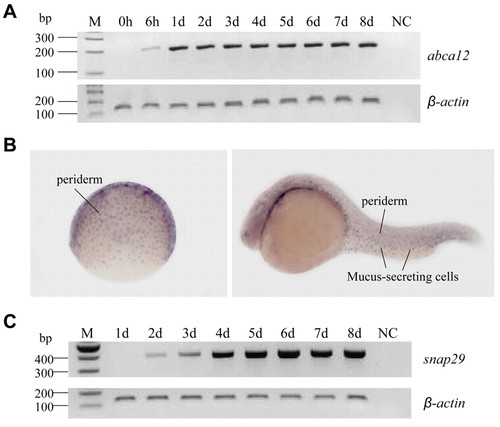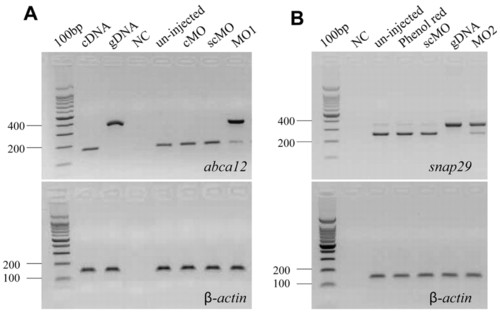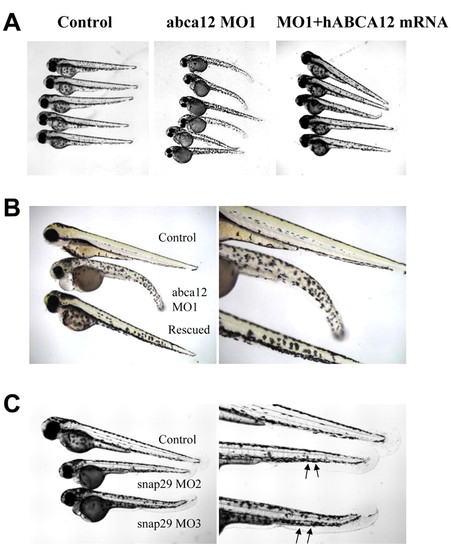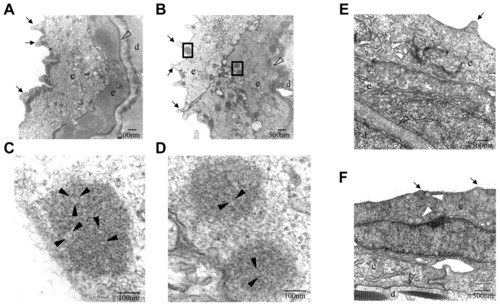- Title
-
Abca12-mediated lipid transport and Snap29-dependent trafficking of lamellar granules are crucial for epidermal morphogenesis in a zebrafish model of ichthyosis
- Authors
- Li, Q., Frank, M., Akiyama, M., Shimizu, H., Ho, S.Y., Thisse, C., Thisse, B., Sprecher, E., and Uitto, J.
- Source
- Full text @ Dis. Model. Mech.
|
abca12 and snap29 gene expression in normal zebrafish. (A?C) Zebrafish embryos were collected at 0 and 6 hpf and 1?8 dpf, and total RNA was isolated and cDNA prepared. The abca12 (A) and snap29 (C) mRNA expression levels were measured by RT-PCR and standardized against the mRNA expression level of the β-actin gene. (B) Whole-mount in situ hybridization of embryos at different stages of early development for abca12 expression; gastrula period (left panel), 24 hpf (right panel). |
|
Knockdown of abca12 and snap29 expression by morpholinos. (A) Knockdown of abca12. (B) Knockdown of snap29. MO1 and MO2 morpholinos (right lanes, the upper panel), which target the splice donor site at the exon-4?intron-4 border of the corresponding genes, prevents pre-mRNA splicing. The consequences of MO1 on abca12 pre-mRNA splicing and MO2 on snap29 mRNA splicing were determined by RT-PCR. The results showed the retention of intron 4 in the majority of mRNA transcripts (>90%) as compared with the normally transcribed control. The mRNA levels were normalized by the level of β-actin mRNA (lower panels). cDNA and gDNA represent amplification of the corresponding complementary DNA and genomic DNA, respectively. Injections with the 5-bp mismatched control morpholino for abca12 (cMO) or global standard control morpholino (scMO) did not alter pre-mRNA processing, similar to the uninjected controls or those injected with phenol red. |
|
Zebrafish phenotypes and their mRNA rescue at 3 dpf. (A) Phenotypic appearance of zebrafish larvae after injection with an abca12 MO1 morpholino (middle panel) compared with control larvae (left panel), and partial rescue with human ABCA12 mRNA (right panel). (B) Higher magnification of the larvae shown in A. (C) Phenotype of larvae at 3 dpf injected with snap29 morpholinos MO2 or MO3. The irregular contour of the epidermis is noted by arrows. PHENOTYPE:
|
|
SEM of the skin surface. The skin of the tail of the control larvae injected with the global standard control morpholino at 3 dpf shows the presence of keratinocytes with well-demarcated cell-cell borders (arrowhead) containing microridges (star; left panel). The morphant larvae injected with MO1 morpholino for abca12 (middle) or snap29 (MO2; right panel) revealed perturbed microridge formation with spicules in the center of the keratinocytes. PHENOTYPE:
|
|
TEM of 3-dpf larvae injected with abca12 or snap29 morpholinos. (A,E) Control morpholino (scMO); (B) abca12 morpholino (MO1). Boxes surrounding electron-dense subcellular structures in B were examined at higher magnification and are shown in C and D. (F) Injection with snap29 morpholino (MO2). (A?F) Arrows point to microridges; open arrowheads indicate basement membrane; solid black arrowheads point to the areas of accumulation of putative lipids within the electron-dense granules in C and D; solid white arrowheads in F point to apparently empty vesicles. e, epidermis; d, developing dermis. |





